Live Noir: Stan Chambers at Henry Ford McCracken's 1952 Murder Trial
Stan Chambers, the veteran Los Angeles TV news reporter whose career at KTLA spanned more than six decades, died Friday, February 13, 2015. Chambers was the in-the-field reporter for the first live telecast of an atomic bomb test, the 1965 Watts Riots, the assassination of Robert F. Kennedy, and the Tate-LaBianca murders by the Manson Family. He also broke the story on the beating of Rodney King by Los Angeles Police Department officers. One of Chamber's first TV reporting jobs was the run-up to and the trial of Henry Ford McCracken for the kidnapping of Patty Jean Hull — California's first live broadcast of a criminal case.
In
Buena Park on May 19, 1951, the parents of 10-year-old Patty Jean
Hull told police their daughter was missing. Four days
later, television cameras zoomed in on Hull's uncoiling story. As
real-time TV signals from Santa Ana's jail radiated throughout Southern
California, we entered the age of broadcast voyeurism.
Stan
Chambers, a living legend of television news, was at the mic to
bring viewers
a "first-hand picture of developments" at
California's first live broadcast of a crime case. The tease: Where
is Patty Jean Hull?
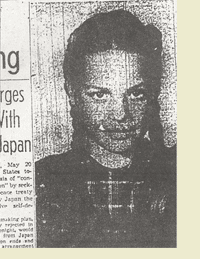 Today,
Hull looks straight at me from my computer monitor. A bitmapped
jpeg of a grammar school class photo taken
at the midpoint of the
20th century, her image is processed into a future she never saw.
It's an amplified future where TV programs starring reluctant
celebrities like Gary Condit, Elizabeth Smart, Jon-Benet Ramsey,
and O.J. Simpson
push the value of image above the value of language. But even
more, as philosopher Jean Baudrillard said in The
Ecstasy of Communication, we live in an age in which "the scene and the mirror have
given way to a screen and a network." Today,
Hull looks straight at me from my computer monitor. A bitmapped
jpeg of a grammar school class photo taken
at the midpoint of the
20th century, her image is processed into a future she never saw.
It's an amplified future where TV programs starring reluctant
celebrities like Gary Condit, Elizabeth Smart, Jon-Benet Ramsey,
and O.J. Simpson
push the value of image above the value of language. But even
more, as philosopher Jean Baudrillard said in The
Ecstasy of Communication, we live in an age in which "the scene and the mirror have
given way to a screen and a network."
If
Hull's case was tried today, CNN, Fox and Court TV might showcase
her story as an infotainment
docudrama — a "Missing Girl
Mystery." They might weigh episode tie-ins and hire ad
agencies to determine her demographic appeal.
Now,
on the 50th anniversary of her case, it's time to retell
Hull's story in the medium her tragedy helped fashion. The
only question
is what screen and what network will premiere her story of
death — and
the birth of reality TV?
"It's
in a rough stage now," I say, describing my Patty Jean Hull
docudrama to Nancy Meyer, a development executive at Universal
Studios. "But
here's what I see."
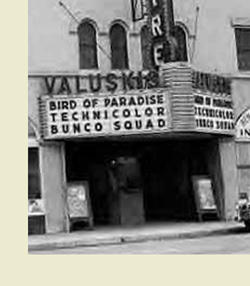 It
is midday on May 19, 1951. A hard light flares off the marquee
at the Buena Park Valuskis
Theater. In the distance,
a man in
a green gabardine sport suit approaches. A few cars scroll
past on
Beach Boulevard
in this agricultural community of citrus growers. Suddenly,
Patty Jean Hull's face pops into full frame. A 10-year-old
in pigtails,
a red sweater, blue jeans, bobby socks, and saddle shoes,
she smiles, turns, takes the hands of her two younger
brothers and
walks to
the ticket window for the matinee. It
is midday on May 19, 1951. A hard light flares off the marquee
at the Buena Park Valuskis
Theater. In the distance,
a man in
a green gabardine sport suit approaches. A few cars scroll
past on
Beach Boulevard
in this agricultural community of citrus growers. Suddenly,
Patty Jean Hull's face pops into full frame. A 10-year-old
in pigtails,
a red sweater, blue jeans, bobby socks, and saddle shoes,
she smiles, turns, takes the hands of her two younger
brothers and
walks to
the ticket window for the matinee.
Meyer listens intently as I continue.
Theater
interior. The
Bird of Paradise, a motion picture playing that
day,
fills the screen. Tiki Room music and
Technicolor
palm trees
set the scene, as André, a white man who has
sailed to Polynesia, is about to marry Kalua, an island
princess.
We zoom in on the screen
as Kalua's brother Tenga explains a native honeymoon
night to André:
TENGA:
You will kidnap Kalua. It would bring great shame to the chief
if he let her
go easily. She must be taken
from
him by force.
ANDRÉ:
But I don't need to take Kalua by force. She wants to come with
me. She loves
me.
TENGA:
That is true, but when you kidnap her, she will fight you and
bite you. That is the custom.
It proves
that she
loves her
parents. It proves that she does not willingly
run from their happy house.
At
the Valuskis Theater, Patty Jean Hull is seated alone, away from
her brothers and the crowd. Someone
approaches.
It's the
man in
the green gabardine sport suit: Henry Ford McCracken.
He sits down immediately
next to her.
"I'm a little lost now," Meyer says. "Who
is McCracken?"
"McCracken
was 34," I say, "a handyman and country musician.
Slicked-back hair, clean-shaven, inconspicuous-looking.
He never touched alcohol. In fact, he wouldn't drink Coke at a bar for fear
it was
spiked."
McCracken
was also a sexual psychopath on a short fuse. In 1946, his concerned
mother
petitioned
the Orange
County Superior
Court
to have
him committed to a mental hospital. His
behavior and record as a serial child sex offender,
however, failed
to impress
medical examiners
who
said he had "mild schizophrenia with
anxiety neurosis but can distinguish between
right and wrong." Diagnosis: no big deal.
"What
else can you tell me about McCracken?" Meyer asks.
After
his "mild
schizophrenia" diagnosis, McCracken moved
from Orange County to Michigan, where
his string of child sex offenses continued. In the fall of 1950,
after nine arrests, Detroit Police
prepared documents to have him permanently
committed to a mental institution. Before the documents were filed,
McCracken fled back to Orange County.
A few weeks later, he was arrested in
Santa Ana for failing to register as a sex offender. He served
a six-month jail sentence. On May 6,
1951, he was on the streets again.
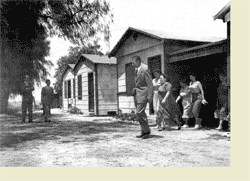 McCracken immediately gravitated to
an auto court cottage down the block
from
the Valuskis
Theater
where he took
up residence.
He worked
nights entertaining at the nearby White
Elephant Cafe. Just 12 days after his
release from
the Santa Ana
Jail, he took
an empty
seat
at a Saturday matinee, next to Patty
Jean Hull. McCracken immediately gravitated to
an auto court cottage down the block
from
the Valuskis
Theater
where he took
up residence.
He worked
nights entertaining at the nearby White
Elephant Cafe. Just 12 days after his
release from
the Santa Ana
Jail, he took
an empty
seat
at a Saturday matinee, next to Patty
Jean Hull.
Meyer
shifts in her seat. "We'd
have to look delicately at a child
sex-offense case like this," she says
"I
can go that way," I say. "Let's
fast forward."
Hull
never returned home from the theater. Her parents
called the
police that night. By
the next morning, nearly every
family in Buena
Park, a community of 5,000,
sent someone out to look for the missing girl.
That
afternoon, on a tip from the owner of the White Elephant Cafe,
police took
Henry Ford
McCracken into custody. He
went quietly. A bloodstained
green gabardine sport suit was found
in his cabin.
Outside
the jail, one of the most exhaustive searches in
Southern
California history
continued. More
than 1,500 people,
including
Boy Scout troops and Marines
from El Toro, scoured hillsides,
orange
groves
and back yards for Hull. They
searched for days with no
luck.
"Now, for the electronic moment of truth," I say to Meyer. "On
Wednesday, May 23, camera
crews arrived on the scene to provide Southern California's television
audience its first exposure to a live crime
drama. After the Hull case,
TV would never be the same."
"I
think if I were to develop this," Meyer says, "I'd say
the murder sounds — I
don't mean this the wrong
way — but
almost incidental."
"But
as history," I say, "I think this story would
be a great lead-in to a live crime series.
Let me just wrap up the pre-trial."
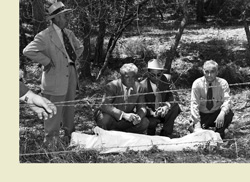 It
is Thursday, May 24, 1951. Our view pans across Live
Oak Canyon. A State
Forest Ranger
crawls
under a barbed-wire
fence
and moves
toward a tiny mound
of dirt marked by a broken branch. The ranger
drops to
his knees and begins
digging with his hands. He stops. Hesitates.
Digs down
deeper. We
zoom in.
We see a
black-and-white saddle
shoe breaking through
the loose dirt that covers this shallow
grave. It
is Thursday, May 24, 1951. Our view pans across Live
Oak Canyon. A State
Forest Ranger
crawls
under a barbed-wire
fence
and moves
toward a tiny mound
of dirt marked by a broken branch. The ranger
drops to
his knees and begins
digging with his hands. He stops. Hesitates.
Digs down
deeper. We
zoom in.
We see a
black-and-white saddle
shoe breaking through
the loose dirt that covers this shallow
grave.
"This
is this all true?" Meyer asks. I nod.
The
camera tilts up and lingers for a moment, registering the emotion
of the
ranger and the grave. The shot dissolves into
the same scene
a few hours later
as police detectives surround Patty Jean's body.
She is
fully
clothed, face up, hands folded across
her stomach.
Back
at the Santa Ana Jail, McCracken
is taken
out of
his cell. Police
wait outside
to transport
him
to the
grave
site. As he
walks down
a corridor in
front of cameras,
District
Attorney
James
L. Davis holds
out a bloodstained
yellow
bed sheet found
near
Patty Jean's
body.
He asks McCracken, "Is
this yours?" There
is no reply.
"This
might be something that Court TV would consider," Meyer
says. "What
happened next?"
I
relate McCracken's
version
of events. He
admitted
to police
that Hull
visited
his cottage
but
said she
panicked when
she thought
her neighbors
were
approaching.
Embarrassed
and
trying
to evade
them,
she attempted
to escape
out a screen
window,
slipped and accidentally
cut herself.
According
to McCracken,
she
passed out.
After
he attempted
to revive
her, he
claims he,
too,
passed out.
Meanwhile,
the autopsy
report
had been
completed.
It documented "small
bruises
on the
girl's
arms and
on the
area of
her thighs,
dilation
of her
rectal
orifice,
some 15
gashes
on her
scalp
at the
back and
sides,
and three
fractures
of her
skull."
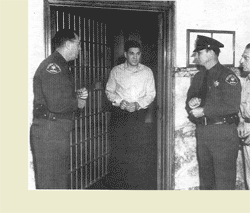 The
TV cameras
surrounding
the
murder were beginning
to
have
their
effect.
Before
the
Aug. 3 trial,
McCracken
attorney
George
Chula
Jr.
filed a change
of venue
request
based,
in part,
on the
claim
that
live
coverage had "aroused
the
anger and indignation
of the
people." Request
denied. The
TV cameras
surrounding
the
murder were beginning
to
have
their
effect.
Before
the
Aug. 3 trial,
McCracken
attorney
George
Chula
Jr.
filed a change
of venue
request
based,
in part,
on the
claim
that
live
coverage had "aroused
the
anger and indignation
of the
people." Request
denied.
Drawing
media
coverage
across
the
country,
the
first
trial
ended
with
a
deadlocked jury.
McCracken
was
found
guilty
of
child stealing,
but
one
juror
dissented
on
the murder
charge.
As
Superior
Court
Judge
Robert
Gardner
dismissed
the
jury,
McCracken
reacted
like
a
child. "I
knew
I wasn't
guilty," he
chanted
over
and
over
again
in court.
As
the
jurors
walked
down
the
stairs
from
the
third-floor
courtroom,
they
hid
their
faces.
A
reporter on the
stairway
landing
lunged
forward
with
his
camera.
A
male juror
shoved
back,
smashing
the
camera
into
the
reporter's
eye.
As
he
stumbled
backward
with
blood
running
down
his
face,
the
reporter
caught
the
juror
with
a
left hook to
the
jaw.
A
brawl followed
between
jurors
and
newsmen.
A
sheriff's deputy
intervened.
There
was outrage
everywhere in
Southern California.
Orange County
citizens organized
rallies to
protest the
verdict. District
Attorney Davis
was so
angered by
the outcome
that he
berated the
jury for
failing to
convict.
Trial
No. 2
was set
to begin
on Aug.
13.
"So
what was the final outcome?" Meyer asks.
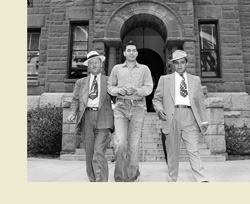 I
tell her that the prosecution at the second trial was
meticulous. The jury was bussed to McCracken's cottage.
This time, there was no mistrial.
McCracken
was found guilty of first-degree
murder. I
tell her that the prosecution at the second trial was
meticulous. The jury was bussed to McCracken's cottage.
This time, there was no mistrial.
McCracken
was found guilty of first-degree
murder.
On
Feb. 19, 1954, after a three-year battle to escape the
gas chamber, McCracken was executed.
I
wait for Meyer's response. "I see murder stories all the time," she
says. "I think the real story
here is how this changed the community and the way people look
at murder.
Have we lost our innocence?"
"That's
exactly how I would focus the story," I explain. "This
is about the birth of crime and reality TV. Cops, Investigative
Reports, The
People's Court — all owe
a debt to the Hull case. Think two words: 'live noir.'"
"Well,
then," Meyer says. "I'll give my friend
at Court
TV a call. It might be something they'd be interested in."
The
meeting is over.
I drive
to North
Hollywood
and bolt down a
cup of
coffee — reassuring
myself
that I can live
with Court
TV. Now,
I just have
to figure
out if
we've
lost our
innocence.
According
to most
late-20th-century
cultural
historians,
the
official
date
of America's "innocence
lost" is
Nov.
22,
1963 — the
day
of
JFK's
assassination.
The
payoff
for
fans
of early
live
crime
coverage
came
two
days
later
on
Nov.
24,
when Jack
Ruby
shot
Lee
Harvey
Oswald dead
before
a live
TV audience.
Like
a NASCAR
race
car
hitting
the
wall
on ESPN,
Ruby's
act
of
expedient
justice
was
the
spectators'
defining
moment
in vicarious
danger.
With
those
same
visceral
and
yet
unrealized
expectations
in
mind,
any
Southern
Californian
who
owned
a TV
in
1951
witnessed
the
spectacle
of
McCracken "live." How
did
this
affect
the
audience?
What
innocence
were
we
presumably
losing?
It
occurs
to
me
that
the
best
point
of
view
for
my
Hull
tele-tragedy
might
be
found
through
the
eyes
of
someone
on
the
scene.
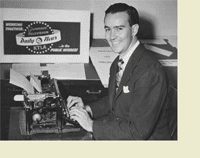 "This was a groundbreaking event in television news," Stan
Chambers
tells me. Chambers, KTLA-TV's on-the-scene reporter, has covered most
of the major events in Southern California over the past 50 years, including
the Hull case. "This was a groundbreaking event in television news," Stan
Chambers
tells me. Chambers, KTLA-TV's on-the-scene reporter, has covered most
of the major events in Southern California over the past 50 years, including
the Hull case.
"You
really have to give credit to station manager Klaus Landsberg," Chambers
says. "His philosophy was to
get the cameras out of the studio and into the field. It all
fell
together on the Patty Jean Hull case. It was his idea to cover
it."
So
it's Landsberg
who lost
our innocence,
I think.
"When the word came out that they were holding McCracken," Chambers
says, "we went over to his
house. Our cameras looked through his front window and
saw all this
pornographic material."
Pornography
broadcast
live
in 1951
to all
of Southern
California?
That's
another
first.
I ask
Chambers
to
describe
it.
"It was mainly magazines," he says. "There wasn't
that much pornography around, so it's hard to be relative
about it."
When
news of
McCracken's whereabouts
got out
via live
TV, a
crowd of
angry locals
gathered
at the
Santa
Ana Jail. "We were there
live," Chambers says. "It
was almost what you would call a lynch mob. There
were some very
nervous moments."
Later,
during
the
trial,
KTLA
had cameras
in the
hallway
outside
the courtroom. "When people
would come in and out of the courtroom
door," Chambers says, "our
cameras would get a peek as to
what was going on.
Then,
when witnesses
finished their testimonies,
we would do interviews. There were
little games being played."
The
Hull
case
also
marked
the first
time
in
California
history
that
newspaper
and TV
reporters
competed
for a
crime
story.
"Once, someone mysteriously knocked the power line out of the wall
so our cameras went off the air. We were looking around wondering where our
signal went. It was chaos."
Then
I ask Chambers the magic question: "Do
you think we lost
a part of our innocence
as a result of our
exposure
to the Hull case?"
"The audience has changed a lot," he says. "In
those days, there was such a thing as real shock. Nothing
like this had happened
to us as broadcasters before, and it hadn't happened to
the people we were interviewing — or the
audience either.
"The scope of news was broadened by events like this," Chambers
says. "News became very much
more visual and began to have a much stronger impact
on people.
You were there right as it was happening. It was reality."
There's "reality," and
then there's "reality."
The
instant
communication
of television
removed
the
wall
between
crime
and
public
reaction.
We saw
Patty
Jean
Hull's mother
covering
her
own face
from
the
camera's
unblinking,
shameless
gaze.
We saw
her listless
brother
crying.
We saw
her father pleading
for
justice.
According
to Baudrillard, "It
is futile to imagine space if
one
can cross it in an instant. Picturing
others and everything that brings
you close to them is futile from
the instant that 'communication'
can make their presence immediate."
With
the advent
of live
crime
TV,
an immediate
presence
confronted
us.
We
could
instantly
see ourselves
in a
victim's
circumstances.
We could
imagine
what
we would
do. We
could
judge
their
reaction. But as
viewers — as voyeurs — the
current flows only one way. We
could take in the victims' first-hand
reactions — to
place, time and circumstance.
But
we could not touch the scene
through
the airwaves.
"In the McCracken case, you've got the ingredients for making
people watch: molestation, sex and a guy who's a sexual
psychopath," Clay
Calvert says.
Calvert
is the
author
of Voyeur
Nation,
a study
of the
cultural
phenomenon
of media-driven
voyeurism.
He
seemed
the
most
likely
candidate
to
help
me
determine
if we've
lost
our innocence
since
this
first
electronic
moment
of
truth. "When we watch things
like the McCracken case on television, we are removed
from actually dealing
with those people. We dip in and out of their lives.
We turn off the TV set, and our responsibility is nil.
We're feeding
off their tragedy and grief."
"Yes, but haven't we always had an interest in other people's misery?" I
ask without shame.
"Mass
voyeurism has been around at least since 1836, when the New York
Herald covered the ax murder of a prostitute," says Calvert,
an assistant professor of communications and law at Penn State. "But
the McCracken case helped to break the mold. It was live.
For the audience,
it was the first time that the outcome was unclear. There
was drama, suspense, it was unscripted — we
didn't know what to expect."
"How is that different than what we see on TV today?" I
ask.
"Since
then, it's been a case of constantly pushing the envelope. Each
generation's audience seems more willing to see more of other
people's private
lives — more willing
to tolerate certain uses of cameras than previous generations were."
"Have we lost our innocence?" I ask.
"We
gaze at our new reality, feeling involved when we may not be," Calvert
says. "With an increasing amount
of TV reality shows, fact and fiction, acting and being are
getting harder
to distinguish."
The
scene
shifts.
It is
1951,
and
we are
once
again
inside
a
theater
at
the screening
of The
Bird
of
Paradise.
TENGA:
As soon
as you
kidnap
her,
the
big
drum
will
sound
the
alarm.
My
father
will
rush
out
in anger
because
someone has
stolen
his
daughter.
And
I
will
rush
out
with
my weapons,
and
all
our
warriors
will
come
with
their
weapons,
and we will
look
for
you.
We
will
look
everywhere.
ANDRÉ:
Where will I be?
TENGA:
You
will
have
carried
Kalua
into
your
house.
ANDRÉ:
But that's the first
place anybody would look.
TENGA:
Yes.
But
we will
not find
you.
That
is the
custom,
too.
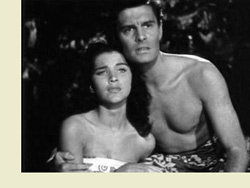 Did
McCracken
find
it increasingly
difficult
between "acting" and "being"?
Did he imagine Patty Jean to be
Debra Paget, who played Kalua in
The Bird of Paradise? Was his kidnapping
of Hull part of some movie-based
delusion? Are we guilty, today,
of sharing a similar part of McCracken's
delusion? Did
McCracken
find
it increasingly
difficult
between "acting" and "being"?
Did he imagine Patty Jean to be
Debra Paget, who played Kalua in
The Bird of Paradise? Was his kidnapping
of Hull part of some movie-based
delusion? Are we guilty, today,
of sharing a similar part of McCracken's
delusion?
I
turn
on
the TV
and surf
through
the
channels.
There's
Judge
Judy
providing
us
with
a
21st
century
pillory.
There's
the parents of Danielle
van Dam,
the once-missing
seven-year-old
San
Diego
girl
whose
body
was found
by a
roadside.
There's
Daniel V.
Jones,
the
Los Angeles
man who
on May
1, 1998,
pulled
his
truck
to
the side
of an
offramp,
set
it on
fire
and
then
shot himself
in
the head
with
a
rifle
on
live
TV.
There's
Law & Order and Fact or Fiction and Law & Order:
Special Victims Unit. There's
Elizabeth
Smart playing the harp and the
skull of Chandra Levy.
When
I get
the call
from
Nancy
Meyer
at
Universal
Studios,
I'm taken
off-guard.
She
goes
straight
to the
point
I
talked to my friend at Court TV," Meyer says. "Unfortunately,
because there are more alarming and lurid cases that have
come
along, your story is not the kind of thing — as she understands
the marketplace — that
she would want to incorporate into programming."
"Incorporate into programming" echoes like a dub remix
in my head.
"That doesn't mean this is the end of it," she offers. "Everyone
has a nose and an opinion. Someone else may have an interest
in this."
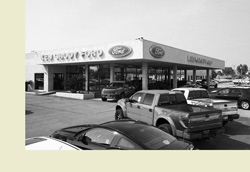 Today,
a hard
light flares
off the
cars at
Ken Grody
Ford in
Buena Park.
This is
where
the Valuskis
Theater once
stood. After
Patty
Jean's
kidnapping, customers
stayed away,
business declined
and the
place shut down.
By the
1960s, the Valuskis had become
a Pussycat
Theater. Now
it's a
car lot.
The
Hull
family home
has been
torn down,
too — so
has the White Elephant Cafe. A little farther down Beach
Boulevard, a
law office occupies the lot where McCracken's cottage
once stood.
Santa Ana's Courthouse still stands at the corner of
Broadway and Santa
Ana Boulevard, but now it's a museum. If you want, you
can sit
in a juror's chair or walk down the hallways where TV
cameras made
history. Today,
a hard
light flares
off the
cars at
Ken Grody
Ford in
Buena Park.
This is
where
the Valuskis
Theater once
stood. After
Patty
Jean's
kidnapping, customers
stayed away,
business declined
and the
place shut down.
By the
1960s, the Valuskis had become
a Pussycat
Theater. Now
it's a
car lot.
The
Hull
family home
has been
torn down,
too — so
has the White Elephant Cafe. A little farther down Beach
Boulevard, a
law office occupies the lot where McCracken's cottage
once stood.
Santa Ana's Courthouse still stands at the corner of
Broadway and Santa
Ana Boulevard, but now it's a museum. If you want, you
can sit
in a juror's chair or walk down the hallways where TV
cameras made
history.
When
I visit
these
places,
Baudrillard's
observation
of the
futility
of
imagining
space
when
distance
can be
diminished by
time
settles
hard
in
my consciousness.
I wonder
how far
we've
actually
come
in
so short
a time
and how
much,
if
any,
innocence
we have lost.
This
July
22,
50 years
will
have
passed
since
the
Supreme
Court
of
California
ruled
on Henry
Ford
McCracken's
appeal. That
ruling
set
another
precedent.
It was
the
first
appeal
in
California
history
in which
live
television
coverage of
a crime
case
was
considered
in
the
determination
of a
fair
and
impartial
trial.
In response
to the
inauguration
of the
electronic
moment
of
truth,
the
appeal
failed.
Since
then,
we
tell
ourselves
that
everything
has
changed.
Because
of
television's
prying
eyes,
we
believe
that our
TV
reality,
as
Baudrillard
wrote
more
than
20 years
ago, "is no longer a
question of imitation, nor duplication,
nor even parody. It is a question
of substituting the signs of the
real for the real."
Yet,
there
has
always
been
a fascination
with
crime
and its
consequences.
In
the past,
we turned
it into
folklore
and
staged it
in theaters.
Since
the
first
cave
drawings,
we
visualized
ourselves
in a
victim's
circumstances
from
a
distance.
We
have
always been
voyeurs,
only
now
we have
another
buffer
zone — our television screen — between "the
signs of the real and the real."
In
the
presence
of projected
images
of
crime
and
its
consequences — and
other people's grief — we
may feel guilty, but we still
watch.
Live or not, the future and
the past coalesce in little
more than
a retinal response. In the
end, Patty Jean Hull stares
out from
this page, and we stare back.
— Nathan Callahan,
July 18, 2002
|